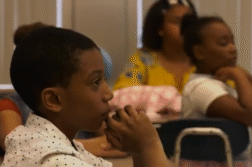ORLANDO, Fla. (Ivanhoe Newswire) — Raising environmentally responsible kids isn’t just about recycling — it’s about results. A global movement that started by two college kids is now teaching children around the world to take real eco-action, from growing food to planting trees.
Sixty-three thousand trees planted. Forty-eight thousand volunteers. Sixty-eight school gardens in 33 countries.
This isn’t just an environmental movement, it’s a hands-on lesson plan for life.
“Eco-action is all about doing something positive for the planet,” said Clayton Louis Ferrara, CEO of IDEAS For Us.
Eco-action is at the core of IDEAS For Us. Ferrara and Chris Castro turn big environmental challenges into local, do-able projects.
“We wanted to have a club that was based around everyday people. We wanted to bring them together, then we want to kind of innovate around solutions. And then we wanted to activate them around something,” explained Ferrara.
IDEAS For Us trains kids and adults to be problem solvers, turning yards into farms and classrooms into gardens.
“We’re now able to give our food away to four schools,” said fleet farming farm manager Bevan Rogers.
They’ve grown nearly 18,000 pounds of produce and planted more than 22,000 shoreline plants.
“It’s cool because we’re having fun, we’re connecting with nature, but at the same time we’re helping people,” said Sharon, a volunteer.
IDEAS For Us launches local think and do tanks, called The Hive, to help communities build customized plans where solutions start with a sharpie and end in action.
“We challenge the public to examine a particular issue. And then we look at those solutions and create an action project,” explained Ferrara.
And that action is empowering kids and communities.
“I want people to know that there is so, so many reasons to be hopeful about the future. And I want them to get inspired to be part of it because we need them,” Ferrara told Ivanhoe.
IDEAS For Us once had clubs at more than 50 universities across the country but found that model hard to sustain. So, they shifted, becoming a global network that partners with schools, nonprofits, and local communities to launch and fund real environmental action projects. If you want to get your child involved, visit https://ideasforus.org/ to find projects, school gardens, or volunteer events near you. It’s not just about learning to care for life on the planet, it’s about doing something to protect it.
Contributors to this news report include: Marsha Lewis, Executive Producer; Matt Goldschmidt, Videographer; and Bob Walko, Editor.
Produced by Child Trends News Service in partnership with Ivanhoe Broadcast News and funded by a grant from the National Science Foundation (NSF).
To receive a free weekly e-mail on positive parenting from Ivanhoe, sign up at: http://www.ivanhoe.com/ftk
If this story or any other Ivanhoe story has impacted your life or prompted you or someone you know to seek or change treatments, please let us know by contacting Marjorie Bekaert Thomas at mthomas@ivanhoe.com



